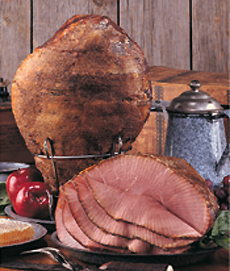
MELODY LAN is a member of THE NIBBLE editorial staff.
|
April 2006
Last Updated July 2012
|
 |
Best Hams To Buy: For The Holiday Or Any Day
Page 2: History Of Ham
This is Page 2 of a six-page review of the best hams to buy via mail order. Below, the history of ham. Click on the black links below to visit other pages.
History of Ham
According to fossils found in the forests and swamps in Europe and Asia, the pig dates back 40 million years. Pigs were domesticated in China by 4900 B.C.E. and were raised in Europe by 1500 B.C.E. It’s difficult to say who was the first to cure a piece of pork to produce ham, but some researchers like Mark Kurlansky, author of Salt: A World History, believe that it was likely to have been the ancient Egyptians. But according to Larousse Gastronomique, a culinary encyclopedia first published in 1938, during the Roman Empire, the finest hams in Europe were produced by the Gauls, who cured pork by burying it at seaside. The meat was immersed in brine, a salt solution, until it was unearthed in the spring. This method is extremely rare today, as most hams are now cured in factories or temperature-controlled rooms to ensure that the curing process is consistent and safe.*
*Today, the USDA must approve hams that are to be sold or shipped throughout the nation; it requires that fresh meat be rubbed with salt or sodium nitrate and nitrite to kill harmful bacteria. While the nitrates and nitrites preserve and enhance the meat’s flavors and shelf life, at high temperatures nitrite can be a potential cancer-causing agent.
Other historians believe that the Chinese cured hams centuries before the meat was even known in Western Europe. The techniques were said to have traveled to Europe along the Silk Road, transforming pork and giving birth to a variety of ham products and flavors worldwide.
Hernando de Soto, a Spanish explorer, first introduced hogs to North America when he brought 13 pigs to Florida in 1539. Upon his death in 1542, his estate auctioned off about 700 descents of the original hogs. Since the settling of Jamestown in the early 1600s, America has been producing hams from pigs that were originally brought to the colonies of Virginia from England and Bermuda for food and sport. The climate of Virginia was ideal for raising pigs. In fact, they became so plentiful that settlers rounded them up and moved them to “Hogs Island” near the James River, where pigs became the main sustenance for Native Americans and newcomers. Native Americans had been curing venison long before the settlers arrived in Jamestown, and legend has it they taught the colonial settlers how to cure meat through salting, smoking and aging. The method was later adapted to preserve razorback pork.
We can’t be sure which group was the first to prepare salt-cured meat, or even when ham was first made. We do know, however, that through trial and error, people throughout history have perfected techniques to turn pork into succulent hams with full-bodied flavors that we enjoy today.
Continue To Page 3: Cuts Of Ham
Go To The Article Index Above
Lifestyle Direct, Inc. All rights reserved. Images are the property of their respective owners.

|




